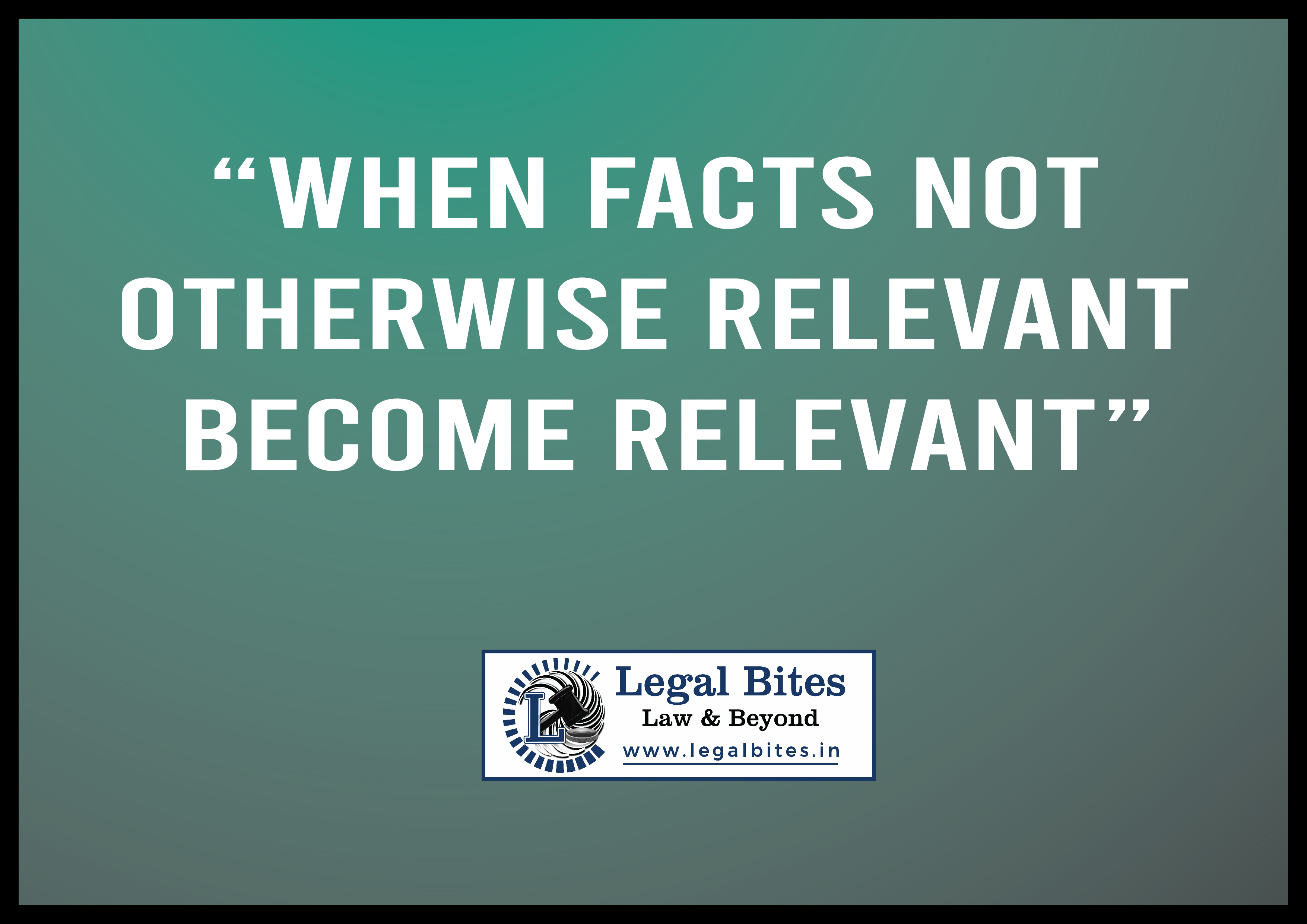When facts not otherwise relevant become relevant
This article on 'When facts not otherwise relevant become relevant' is written by Tejas Vasani and focuses on the section 11 of the Indian Evidence Act. I. Introduction Section 11 of the Indian Evidence Act, 1872, provides for situations in which facts otherwise not relevant may become relevant. It reads as, "Facts not otherwise relevant are relevant –– (1)… Read More »

This article on 'When facts not otherwise relevant become relevant' is written by Tejas Vasani and focuses on the section 11 of the Indian Evidence Act. I. Introduction Section 11 of the Indian Evidence Act, 1872, provides for situations in which facts otherwise not relevant may become relevant. It reads as, "Facts not otherwise relevant are relevant –– (1) if they are inconsistent with any fact in issue or relevant fact; (2) if by themselves or in connection with other facts they...
This article on 'When facts not otherwise relevant become relevant' is written by Tejas Vasani and focuses on the section 11 of the Indian Evidence Act.
I. Introduction
Section 11 of the Indian Evidence Act, 1872, provides for situations in which facts otherwise not relevant may become relevant. It reads as, "Facts not otherwise relevant are relevant –– (1) if they are inconsistent with any fact in issue or relevant fact; (2) if by themselves or in connection with other facts they make the existence or non-existence of any fact in issue or relevant fact highly probable or improbable." If a fact, which is otherwise irrelevant, disproves or tends to prove or disprove a fact in issue or a relevant fact, the irrelevant fact becomes a relevant one. The section is capable of having a wide scope. However, reading the section in an unreasonably broad sense would defeat the purpose of the Evidence Act.[1]
The admissibility of a fact under this section must depend upon the following-[2]
- The proximity in the relation between the fact in issue and the fact sought to be proved.
- The extent to which it would tend to prove or disprove the fact in issue when considered alongside the other facts in the case.
- The extent to which the evidence is otherwise inadmissible under the Evidence Act.
II. Plea of Alibi
There are certain facts that cannot be said to have co-existed with another fact. If one fact is proved to be true for a person, another fact that cannot co-exist with the fact so proved automatically stands disproved. This is the principle behind the concept of alibi according to which if the accused is proved to have been present at a different place at the same time when the offence was committed, it is concluded that the person was not physically present during the commission of the offence.
A plea of alibi must be established with absolute certainty. In a case where it was proved that the person was not physically present at the place where the act was alleged to have been committed but was present only a few miles away from such place, the plea of alibi was not allowed.[3] Where the accused claimed that he was present at a different place when the offence was committed but failed to provide proof of the distance between the two places, the plea of alibi was not allowed.[4] In another case, the presence of the accused was clearly established by FIR, dying declarations and medical evidence. The Court held that a plea of alibi is not of any worth in such a case.[5]
In cases of circumstantial evidence, a false plea of alibi can be used as a link in the chain of circumstances. However, it cannot be the sole incriminating circumstance.[6] Plea of alibi is required to be proved only after the prosecution has sufficiently established its case against the accused.[7]
III. Highly probable or improbable
The words "highly probable or improbable" used in clause (2) of the section refers to the degree of connection between the fact in issue or relevant fact and a collateral fact. For a fact otherwise not relevant to be relevant under this section, it has to clearly establish the existence or non-existence of a fact in issue or a relevant fact. The degree of probability must be sufficiently high enough and not merely reasonable.[8]
In Sarojekumar Chakrabarti v. Emperor,[9] the fact in issue was pertaining to possession of a revolver. The fact that an identical revolver was publicly showed by the accused three weeks before was held to be relevant under section 11 of the Evidence Act.
In Mahender Singh Dahiya v. State (CBI),[10] the husband was accused of killing his wife. The letters written by the wife to the husband were not considered to be relevant under the section since they failed to establish a high degree of probability.
Edited by- Akriti
References
[1] Reg v. Prabhudas, (1874) 11 BHC 90, 9.
[2] Htin Gyaw v. King-Emperor, (1927) 6 Ran 6, 14.
[3] State of Maharashtra v. Narsingrao, AIR 1984 SC 63.
[4] Ashok Rai v. State of U.P., 2014 Cr LJ 3085 (SC).
[5] Munir Ad v. State of Rajasthan, AIR 1989 SC 705.
[6] Babudas v. State of M.P., 2003 Cr LJ 2536 (SC).
[7] Darshan Singh v. State of Punjab, (2016) 3 SCC 37.
[8] Bhuriya v. Ram Kali, AIR 1971 Punj 9.
[9] (1932) 59 Cal 1361.
[10] 2003 Cr LJ 1908 (Del).

